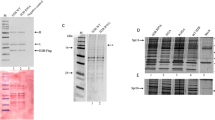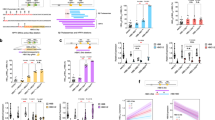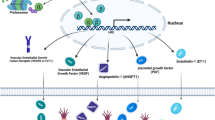Abstract
Two novel mutations, 602–605delAAAG in exon 5 and Int1(+12)C>A, of the F13A1 gene were identified in a Chinese factor XIII (FXIII)-deficient family. The 602–605delAAAG mutation results in the premature termination of translation. To determine the functional effect of the Int1(+12)A mutation, we transiently expressed luciferase reporters in U937 cells. We found that the first 951 bp of F13A1 intron 1 is involved in regulating the expression of the F13A1 gene and that Int1(+12)A results in its reduced expression. Electrophoretic mobility shift assay indicated that Int1(+12)A causes reduced protein binding. An Sp1 site was predicted in the sequence containing Int1(+12)C, which the Int1(+12)A mutation eliminates. Co-transfection of a plasmid expressing Sp1 revealed that Sp1 is involved in regulating the expression of FXIIIA and that Int1(+12)A leads to inefficient transcription. These results provide the first insight into a novel regulatory mechanism involving intron 1 in the F13A1 gene.
Similar content being viewed by others
Log in or create a free account to read this content
Gain free access to this article, as well as selected content from this journal and more on nature.com
or
References
Karimi, M., Bereczky, Z., Cohan, N. & Muszbek, L. Factor XIII deficiency. Semin. Thromb. Hemost. 35, 426–438 (2009).
Hsieh, L. & Nugent, D. Factor XIII deficiency. Haemophilia 14, 1190–1200 (2008).
Ichinose, A. Physiopathology and regulation of factor XIII. Thromb. Haemost. 86, 57–65 (2001).
Anwar, R. & Miloszewski, K. J. A. Factor XIII deficiency. Br. J. Haematol. 107, 468–484 (1999).
Trinh, C. H., Elsayed, W., Eshghi, P., Miri-Moghaddam, E., Zadeh-Vakili, A., Markham, A. F. et al. Molecular analysis of sixteen unrelated factor XIIIA deficient families from south-east of Iran. Br. J. Haematol. 140, 578–592 (2008).
Castaman, G., Giacomelli, S. H., Ivaskevicius, V., Schroeder, V., Kohler, H. P., Dragani, A. et al. Molecular characterization of five Italian families with inherited severe factor XIII deficiency. Haemophilia 14, 96–102 (2008).
Trigui, N., Frère, C., D'Ercole, C., Chambost, H., Chapuis, N., Pouymayou, C. et al. Molecular characterization of a novel mutation in the factor XIII A subunit gene associated with a severe defect and an adulthood diagnosis. Haemophilia 13, 221–222 (2007).
Ariens, R. A. S., Kohler, H. P., Mansfield, M. W. & Grant, P. J. Subunit antigen and activity levels of blood coagulation factor XIII in healthy individual. Relation to sex, age, smoking and hypertension. Arterioscler. Thromb. Vasc. Biol. 19, 2012–2016 (1999).
Kida, M., Souri, M., Yamamotot, M., Saito, H. & Ichinose, A. Transcriptional regulation of cell type-specific expression of the TATA-less A subunit gene for human coagulation factor XIII. J. Biol. Chem. 274, 6138–6147 (1999).
Attié-Castro, F. A., Zago, M. A., Lavinha, J., Elion, J., Rodriguez-Delfin, L., Guerreiro, J. F. et al. Ethnic heterogeneity of the factor XIII Val34Leu polymorphism. Thromb. Haemost. 84, 601–603 (2000).
Heng, C. K., Lal, S., Saha, N., Low, P. S. & Kamboh, M. I. The impact of factor XIIIa V34L polymorphism on plasma factor XIII activity in the Chinese and Asian Indians from Singapore. Hum. Genet. 114, 186–191 (2004).
Rohrer, J. & Conley, M. E. Transcriptional regulatory elements within the first intron of Bruton's tyrosine kinase. Blood 91, 214–221 (1998).
Shamsher, M. K., Chuzhanova, N. A., Friedman, B., Scopes, D. A., Alhaq, A., Millar, D. S. et al. Identification of an intronic regulatory element in the human protein C (PROC) gene. Hum. Genet. 107, 458–465 (2000).
Warnecke, C., Willich, T., Holzmeister, J., Bottari, S. P., Fleck, E. & Regitz-Zagrosek, V. Efficient transcription of the human angiotensin II type 2 receptor gene requires intronic sequence elements. Biochem. J. 340, 17–24 (1999).
Tanaka, S. & Ramirez, F. The first intron of the human α2(I) collagen gene (COL1A2) contains a novel interferon-γ responsive element. Matrix. Biol. 26, 185–189 (2007).
Girousse, A., Tavernier, G., Tiraby, C., Lichtenstein, L., Iacovoni, J. S., Mairal, A. et al. Transcription of the human uncoupling protein 3 gene is governed by a complex interplay between the promoter and intronic sequences. Diabetologia 52, 1638–1646 (2009).
Acknowledgements
This work was supported by grants from the Natural Science Foundation of China (no. 30060037) and the National Ministry of Education (no. 03147). We thank Professor Akitada Ichinose and Dr Rashida Anwar for their helpful discussions. We also thank the patients and their family for their cooperation and support. We thank Drs DF Zhou, KJ Dong and GQ Zhang for their technical assistance.
Author information
Authors and Affiliations
Corresponding author
Ethics declarations
Competing interests
The authors declare no conflict of interest.
Additional information
Supplementary Information accompanies the paper on Journal of Human Genetics website
Rights and permissions
About this article
Cite this article
Wang, W., Huang, L., Ma, Q. et al. Homozygous intronic mutation leading to inefficient transcription combined with a novel frameshift mutation in F13A1 gene causes FXIII deficiency. J Hum Genet 56, 460–463 (2011). https://doi.org/10.1038/jhg.2011.41
Received:
Revised:
Accepted:
Published:
Issue date:
DOI: https://doi.org/10.1038/jhg.2011.41
Keywords
This article is cited by
-
Eight novel F13A1 gene missense mutations in patients with mild FXIII deficiency: in silico analysis suggests changes in FXIII-A subunit structure/function
Annals of Hematology (2014)
-
A common F13A1 intron 1 variant IVS1+12(A) is associated with mild FXIII deficiency in Caucasian population
Annals of Hematology (2013)
-
Congenital factor XIII deficiency: A commentary on ‘Homozygous intronic mutation leading to inefficient transcription combined with a novel frame-shift mutation in F13A1 gene causes FXIII deficiency’
Journal of Human Genetics (2011)



